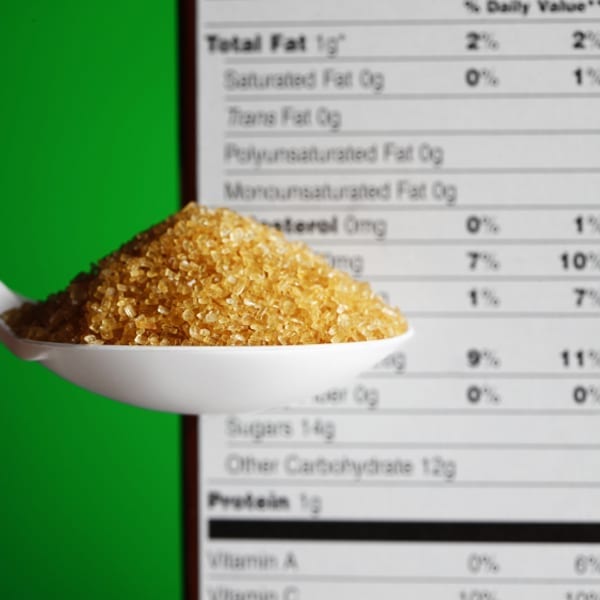The truth about food labels
Are you seduced by packaging proclaiming something yummy-looking is low in fat or sugar? Susan Low reminds us that, in the world of food, the adage ‘all that glitters is not gold’ still very much applies.

Food labels are funny things. The big, glossy picture on the front of the packet is there to entice, but the small print is the reality check. Health-conscious shoppers are encouraged to read food labels to get to grips with how healthy (or otherwise) particular foods are, and those labels are meant to inform. European law requires that ‘the labelling and presentation of food should not mislead the consumer’. Yet confusion still reigns in the UK’s supermarket aisles, and the words on food labels aren’t always as clear as they seem. Here are a few frequently used terms – and our verdict on how useful they really are.
LOW FAT, REDUCED FAT, LIGHT OR ‘LITE’
The hope These are some of the most alluring terms to consumers who want to eat more healthily by cutting down on fat. But a ‘low-fat’ label may not be all it seems.The facts Manufacturers can use these terms only in certain circumstances. They must explain on the label what’s been reduced (such as fat or calories), and the product must be 30% lower in either calories or fat than the standard product.
So far, so good. But lower-fat foods, such as yogurts or ready-made foods, can be higher in sugar and salt than an equivalent product that makes no such claims. And although some reduced-fat foods (such as crisps) may have less fat than the standard sort, they can still be quite high in fat.
Our verdict
: This signposting is a step in the right direction, but tread carefully. If you’re concerned about your fat intake, take the time to read the label. Foods marked low-fat ought to have no more than 3g (or less) of fat per 100g and 1.5g (or less) of saturated fat per 100g to be classed as low in saturated fats. Saturated fats are firm at room temperature; these include butter, lard, ghee, coconut oil and palm oil, all of which can increase the risk of heart disease. Also, think hard about labels that say things such as ’80% fat-free’. ‘20%’ doesn’t sound quite so alluring – but that’s what it means.
NO ADDED SUGAR
The hope Sugar is associated with high-calorie food, so it’s another of the ingredients health-conscious shoppers tend to avoid. The facts Foods that don’t have added sugar aren’t necessarily any more healthy. Soft drinks, for example, may have artificial sweeteners such as sorbitol or aspartame added instead (which some people choose to avoid),
as do some ‘diet’ versions of prepared sweets and puddings.
Our verdict:
If you have a sweet tooth, don’t try to cut out foods with sugar in them; eat them in moderation. Or go for ripe, in-season fruits, which may have high amounts of naturally occurring sugars but are also high in fibre and essential nutrients such as vitamin C.
HEALTHIER OPTIONS
The hope Who wouldn’t want to choose healthy food over a less healthy alternative? The distinction, though, isn’t always clear-cut.The facts Until the summer of 2007, food manufacturers were allowed to make health claims (such as ‘helps maintain a healthy heart’ or ‘good for your gut’) on food labels, even when evidence about such claims was scanty. The rules are now clearer (thankfully); manufacturers must back up health claims made with clear explanations. The results of this rule are still coming into effect, however, in order to give manufacturers the chance to change their labelling, so don’t believe everything you read just yet.
Our verdict:
Scepticism is healthy. Approach health claims with caution. If a claim sounds too good to be true, it probably is. The healthiest foods are those that come without a label, such as fresh, unprocessed fruit, vegetables and grains. American food writer Michael Pollan, author of The Omnivore’s Dilemma, wrote these sage words: “Don’t eat anything your great-grandmother wouldn’t recognise as food.” We’d happily eat to that.
SALT, SODIUM – CAN YOU TELL?
It’s generally accepted that Britons consume too much salt, which can lead to high blood pressure. But have you ever tried reading the label to see how much salt is in your food? It’s not as obvious as it could be because some food makers list sodium instead of salt. Sodium is a component of salt – to get the salt content of a portion, you need to multiply the number of grams of sodium by 2.5. It also helps to know that the recommended daily salt intake for adults is a maximum of 6g (2.4g for sodium), but that’s not always found on the label either.
FRESH, PURE AND NATURAL?
Such words may sound fantastic – but they mean nothing at all. Consumers’ association Which? has carried out research that suggests consumers are as confused as ever about these terms. The Food Standards Agency (FSA) publishes guidance about how such terms should be used, but the advice isn’t legally binding and some companies continue to mislead. Although rules are due to be tightened, don’t be sucked in without reading the label to find out what the information really means.
Subscribe to our magazine
Food stories, skills and tested recipes, straight to your door... Enjoy 5 issues for just £5 with our special introductory offer.
Subscribe
Unleash your inner chef
Looking for inspiration? Receive the latest recipes with our newsletter